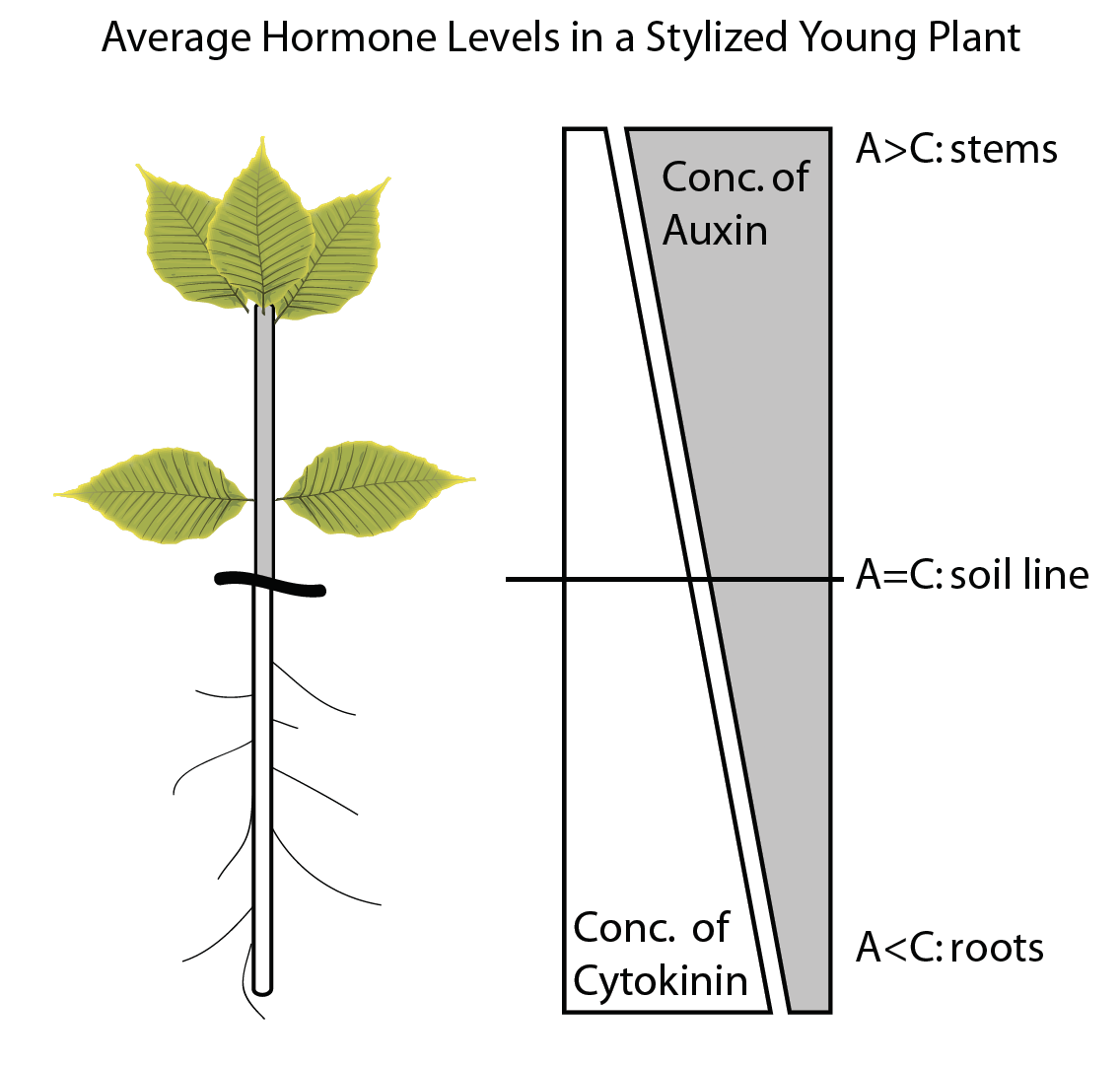Chapter 13 ABC’s of Plant Hormones
Plants use hormones to sense then adapt to their changing environment. These molecules are made in one specific spot in a plant, move through the sap and tissue fluids from their source to a target, then trigger specific changes at another location. Plant hormones are grouped into families that regulate every stage of a plantʼs life: seed germination, seasonal growth, flowering, leaf fall, and even death.
Many horticultural and styling practices work by changing the levels or balance of certain hormones in a plant. Once you know where the hormones come from and what they do, you can better predict and control what will happen as you care for, prune, and style a tree.
The easy way to remember the main hormone families is alphabetically. The table below lists them with a brief description of their main functions.
| Name | Functions |
|---|---|
| Auxins | Make stems lengthen, bend up or toward light. Make roots branch, bend downward. Cause apical dominance. |
| Brassinolides | Make undifferentiated cells in a callus or growing tip form a specific structure, like a woody branch, leaf, flower, or root. |
| Cytokinins | Make roots lengthen, but above–ground stems branch. Stimulate random cell growth, callus formation. |
| Drought & dormancy hormones | Also called abscisic acids. Shut down plant growth, reduce water usage during drought. Block seed germination, keep buds dormant in winter. |
| Ethylene | A gas made by ripening bananas and apples. Low levels thicken branches and stems. Medium levels stop growth, cause autumn leaf drop. High levels kill plants. |
| Fear factors | Volatile chemicals released from a site of injury or infection. They spread in air and cause the rest of plant (and often neighboring plants) to turn on powerful chemical defenses. |
| Gibberellins | Stimulate seed germination, bud break in spring, flowering, fruit formation after pollination. |
13.1 Auxins & Cytokinins Work as Partners
Think about the shape of a young plant or tree. When the seed first germinates, it sends out one long shoot that forms the main stem of the plant. This stem (trunk) acts as the central axis for the rest of the plantʼs growth. Above ground the stem lengthens and divides to form branches, while below ground it forms roots. So how does a plant “know” where the roots versus branches should be? How does it keep them balanced? What makes the stem and root branch? All three events are controlled by auxins and cytokinins.
Most of the auxins (A) are made in the growing tips of stems and branches, while most of the cytokinins (C) are made near the tips of larger roots. These two hormones form opposite concentration gradients. Areas containing more cytokinins than auxins form roots, while areas with more auxins than cytokinins form shoots and branches. At the soil line, where roots change to shoots, the two hormones are about equally concentrated.

Relative ratios of auxin to cytokinins in a plant.
A plant or tree will try to maintain this balance of A to C; if the roots are cut back or stop growing, growth above ground tends to slow down too. The top may even die back, to keep the mass of roots and stems balanced. A more serious problem occurs when the top of a tree is pruned severely, and the roots begin to die back to compensate. Dead branches can be sealed, but excessive root dieback can let in fungal and bacterial rots. If too many roots die, the entire tree is killed. This is why it is so important to check the roots regularly of trees you are pruning often. It also helps explain why we are advised to prune the tops and roots of mature trees at the same time.
Auxins and cytokinins do more than control root to shoot balance. Auxins make stems grow longer, but prevent their branching. The dominant leader of a tree produces the most auxins, so it gets longer while it also blocks the other branches from growing. Below ground the cytokinins are at their highest concentration in the main tap root; they make the main tap root lengthen, but prevent it from branching.
To stimulate new branches to form and lengthen, we have to temporarily raise the concentration of cytokinins relative to auxins in the aboveground stems; to stimulate root branching we must do the opposite, and increase the relative concentration of the auxins. Fortunately, we can reduce these hormones simply by removing their sources. When you cut back a main leader to stimulate back– budding or make side branches lengthen, you are removing the main source of auxins. This shifts the hormone balance towards cytokinins, which triggers branching. Pinching out growing tips to encourage twiggy growth is based on the exact same principle. More extreme manipulation of auxins can fatten up a single side branch of a tree quickly; removing all of the growing tips except those on the selected branch will direct most of the plantʼs energy towards extending that one branch.
Cytokinins are reduced by pruning the roots rather than branches. Cutting back the tap root reduces the amount of cytokinins and briefly raises the relative amount of auxins in the roots. This is what stimulates root branching. Repeatedly cutting back larger roots stimulates repeated root branching, and ultimately creates that mass of fine, highly desirable feeder roots we want.
The balance of auxins and cytokinins can be manipulated using artificial chemicals. Rooting hormone is a mix of talc or cornstarch with indole acetic acid (IAA) or a related chemical. These compounds stimulate the same hormone receptors as naturally occurring auxins. By doing so they trigger cells in the stem of a cutting to reorganize and form new roots.
To learn more about the other hormones, read about the physiology of dormancy.